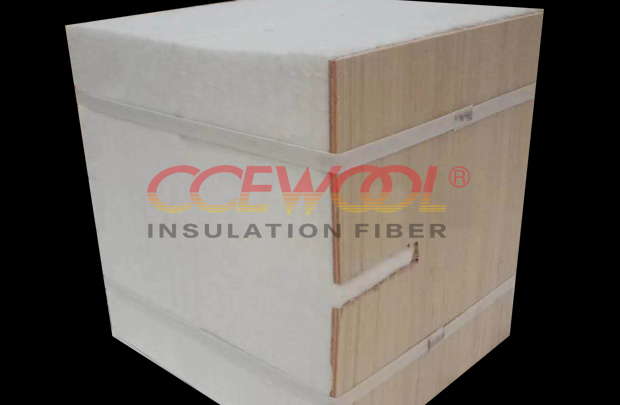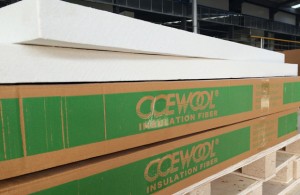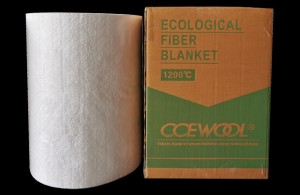Central hole hoisting type:
The central hole hoisting fiber component is installed and fixed by bolts welded on the furnace shell and a hanging slide embedded in the component. The characteristics include:
1. Each piece is fixed individually, which allows it to be disassembled and replaced at any time, making maintenance very convenient.
2. Because it can be installed and fixed individually, the installation arrangement is relatively flexible, for instance, in a “parquet floor” type or arranged in the same direction along the folding direction.
3. Because the fiber component of single pieces corresponds to a set of bolts and nuts, the inner lining of the component can be fixed relatively firmly.
4. It is especially suitable for the installation of the lining at the furnace top.
Insertion type: the structure of embedded anchors and the structure of no anchors
Embedded anchor type:
This structural form fixes ceramic fiber modules through angle iron anchors and screws and connects the modules and the furnace wall’s steel plate with bolts and nuts. It has the following characteristics:
1. Each piece is fixed individually, which allows it to be disassembled and replaced at any time, making maintenance very convenient.
2. Because it can be installed and fixed individually, the installation arrangement is relatively flexible, for instance, in a “parquet floor” type or arranged in the same direction sequentially along the folding direction.
3. The fixation with screws makes the installation and fixing relatively firm, and the modules can be processed into combination modules with blanket strips and special-shaped combination modules.
4. The big gap between the anchor and the working hot surface and the very few contact points between the anchor and the furnace shell contribute to the good heat insulation performance of the wall lining.
5. It is especially used for the installation of wall lining at the furnace top.
No anchor type:
This structure requires the installation of modules on site while fixing screws. Compared with other modular structures, it has the following characteristics:
1. The anchor structure is simple, and the construction is quick and convenient, so it is especially suitable for the construction of large-area straight furnace wall lining.
2. The big gap between the anchor and the working hot surface and the very few contact points between the anchor and the furnace shell contribute to the good heat insulation performance of the wall lining.
3. The fiber folding module structure connects adjacent folding modules into a whole through screws. Therefore, only the structure of arrangement in the same direction sequentially along the folding direction can be adopted.
Butterfly-shape ceramic fiber modules
1. This module structure is composed of two identical ceramic fiber modules between which a heat-resistant alloy steel pipe penetrates the fiber modules and is fixed by bolts welded to the furnace wall steel plate. The steel plate and the modules are in seamless contact with each other, so the entire wall lining is flat, beautiful and uniform in thickness.
2. The rebound of the ceramic fiber modules in both directions is same, which fully guarantees the uniformity and tightness of the module wall lining.
3. The ceramic fiber module of this structure is screwed as an individual piece by bolts and heat-resistant steel pipe. The construction is simple, and the fixed structure is firm, which fully guarantees the service life of the modules.
4. The installation and fixing of individual pieces allow them to be disassembled and replaced at any time, making maintenance very convenient. Also, the installation arrangement is relatively flexible, which can be installed in a parquet-floor type or arranged in the same direction along the folding direction.































